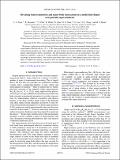Deviating band symmetries and many-body interactions in a model hole-doped iron pnictide superconductor
Author(s)
Hsieh, David; Wray, L. A.; Thomale, R.; Platt, C.; Qian, D.; Chen, G. F.; Luo, J. L.; Wang, N. L.; Hasan, M. Z.; ... Show more Show less
DownloadWray-2012-Deviating band symmetries and many-body interactions.pdf (1.419Mb)
PUBLISHER_POLICY
Publisher Policy
Article is made available in accordance with the publisher's policy and may be subject to US copyright law. Please refer to the publisher's site for terms of use.
Terms of use
Metadata
Show full item recordAbstract
We present a polarization-resolved study of the low-energy band structure in the optimally doped iron pnictide superconductor Ba[subscript 0.6]K[subscript 0.4]Fe[subscript 2]As[subscript 2] (T[subscript c]=37 K) using angle-resolved photoemission spectroscopy. Polarization-contrasted measurements are used to identify and trace all three low-energy holelike bands predicted by local density approximation (LDA) calculations. The photoemitted electrons reveal an inconsistency with LDA-predicted symmetries along the Γ-X high-symmetry momentum axis, due to unexpectedly strong rotational anisotropy in electron kinetics. We evaluate many-body effects such as Mott-Hubbard interactions, which are likely to underlie the anomaly, and discuss how the observed deviations from LDA band structure affect the energetics of iron pnictide Cooper pairing in the hole-doped regime.
Date issued
2012-10Department
Massachusetts Institute of Technology. Department of PhysicsJournal
Physical Review B
Publisher
American Physical Society
Citation
Wray, L. et al. “Deviating Band Symmetries and Many-body Interactions in a Model Hole-doped Iron Pnictide Superconductor.” Physical Review B 86.14 (2012). © 2012 American Physical Society
Version: Final published version
ISSN
1098-0121
1550-235X